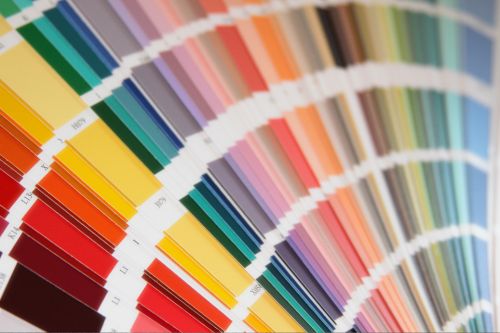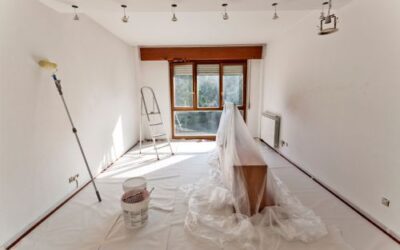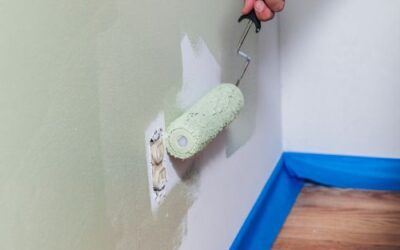When it comes to renovating the paintwork in your home, the choice of colour is crucial to define the ambience and style of each space. Nowadays, interior colour trends have evolved, combining modern and timeless tones to achieve cosy atmospheres full of personality. If you are thinking of painting your flat, we offer you a guide to the colours that are in fashion and how to apply them effectively in each room.
Neutral colours: a safe bet for any space
The versatility of grey tones
Grey remains one of the most popular colours for interiors due to its versatility. From light to darker shades, grey can bring sophistication or a relaxing ambience, depending on how you combine it. Light greys work especially well in smaller rooms, as they help to give a feeling of spaciousness. Dark greys, on the other hand, can add drama to large living rooms or workspaces, combining perfectly with modern or industrial style furnishings.
Contact our professionals
Off-white: the classic that never goes out of style
Off-white is an excellent choice if you are looking for a neutral base on which to add decorative details in brighter colours. Unlike pure white, which can be cold and clinical, off-white brings warmth, creating cosy atmospheres without losing luminosity. This colour is ideal for living rooms, bedrooms and any space you want to make visually larger. It is also an excellent backdrop for works of art or natural wood furniture, enhancing the sense of balance and harmony in decoration.
Earth colours: connecting with nature
Beige and sand: warm tones for the home
Earth tones, such as beige and sand, are gaining popularity for their ability to convey calm and comfort. These colours are perfect for those looking to create cosy spaces, especially in bedrooms or living areas. They work well in combination with natural materials such as wood or linen, giving a very trendy rustic or Scandinavian style. In addition, earth tones have the advantage of being timeless, so you won’t get tired of them easily and they can always be adapted to future changes in decoration.
Soft browns for a sophisticated touch
Brown in its softer versions is also making a strong comeback. Applied in accents or even on entire walls, this colour can add warmth without being overwhelming. Ideal for areas such as dining rooms or living rooms, soft brown combines well with metallic tones, creating elegant environments. This colour also fits perfectly with decorative styles such as boho chic or industrial, allowing spaces to have personality without being too dark.
Pastel tones: softness and luminosity
The return of pastel blue
Pastel blue has re-emerged as one of the most elegant options for restful rooms, such as bedrooms or quiet living rooms. This colour brings serenity and has the ability to transform a space into a relaxing haven. You can combine it with whites or soft greys for a more neutral atmosphere, or add gold accents for a more sophisticated touch. In addition, pastel blue reflects natural light well, making it an excellent choice for small or dimly lit rooms.
Mint green: fresh and stylish
Mint green is another pastel shade that has gained popularity for its freshness and modernity. It is ideal for kitchens, bathrooms or any space where you want to feel a connection with nature. Being a relaxing and fresh colour, mint green is also used in workspaces or studios to encourage creativity and reduce stress. If you want to add a modern touch to your home, combine it with furniture with simple lines and materials such as marble or metal.
Dark colours: a bold trend
Navy blue: sophistication and depth
Navy blue is a dark colour that is increasingly being used in interior decoration. Although it has traditionally been associated with formal or classic environments, it is now a trend in modern spaces that seek a touch of elegance. Using navy blue on an accent wall or on all the walls in a room can create a dramatic effect without sacrificing a sense of calm. In addition, this colour pairs well with gold, silver or white accents, creating a perfect contrast for a refined ambience.
Emerald green: luxury and nature
Emerald green is another on-trend dark colour, ideal for spaces that want to convey luxury and sophistication. This deep shade is perfect for living rooms, studios or even bedrooms when paired appropriately with lighter decorative elements. Emerald green, together with materials such as velvet, marble or dark wood, brings an air of exclusivity to any room. To balance its intensity, it is advisable to use it on a single wall or in key decorative elements.
Vibrant colours: for the more daring ones
Mustard: a touch of energy and cheerfulness
Mustard is ideal for those looking to add a touch of energy and vitality to their home. This vibrant shade has become a trend thanks to its ability to transform neutral spaces into more dynamic environments. It works particularly well in combination with grey or brown tones, and is ideal for living rooms, dining rooms or even offices where creativity is encouraged. Mustard can also be used in small accents, such as cushions or pictures, if you don’t want to paint an entire wall in this shade.
Terracotta: warmth and personality
Terracotta is a vibrant but warmer colour, evoking natural landscapes and Mediterranean environments. Using this colour on an accent wall or in decorative details can bring a sense of warmth without losing elegance. It is ideal for spaces such as living rooms or entrances, where a striking first impression is sought. In addition, terracotta combines perfectly with natural materials such as stone or brick, making it an excellent choice if you are looking for a modern rustic style.
How to combine colours: keys to create harmony
Monochromatic palettes
One of the best ways to apply trendy colours is through monochromatic palettes, where different shades of the same colour are used. For example, you can paint the walls of a living room in a light shade of grey and add furniture or decorations in darker shades of grey. This technique is not only easy to apply, but also guarantees a harmonious and elegant result, perfect for any room in the home.
Contrasting colours
If you prefer a bolder style, colour contrasts are an excellent option. You can combine a neutral tone, such as off-white or light grey, with more vibrant colours such as navy blue or emerald green. Such combinations create an interesting visual impact and give rooms a modern feel. It is ideal for those who want to personalise their home without compromising the elegance and cohesion of the décor.
Materials and finishes that complement trendy colours
Matt paint: understated elegance
Matte paint is one of the most popular choices for those looking for a soft, non-glossy finish. This type of finish is ideal for dark colours such as navy blue or emerald green, as it adds depth without reflecting too much light. In addition, matt paint is excellent for covering imperfections on walls, making it a practical and aesthetically pleasing option.
Satin paint: a touch of light
Satin paint, on the other hand, offers a slight sheen that reflects light, making colours appear more vivid. This finish is perfect for colours such as mint green or mustard, as it enhances their luminosity without being as shiny as a glossy finish. Satin paint is ideal for kitchens, bathrooms or any space where you want an extra touch of light without losing sophistication.
Other publications that may interest you
Paint suitable for basements and poorly ventilated rooms
Basements, storerooms or garages have unique conditions: poor ventilation, high humidity and increased risk of mould or condensation. Using conventional paint in these spaces is a common mistake that leads to ephemeral finishes and health problems due to fungi or...
How often should a house be painted depending on its use?
The frequency with which you should paint a house is not always the same. It depends on several factors: the use given to each room, the quality of the paint used, exposure to light or humidity, and even the colour. In this guide we explain how often you should renew...
Tips for painting a room without staining doors and sockets
Painting a room may seem like a simple task, but without the right preparation it's easy to end up with splashes on doors, sockets, switches and even skirting boards. If you want a clean, professional finish, we've got the best tips to avoid stains and save you...




